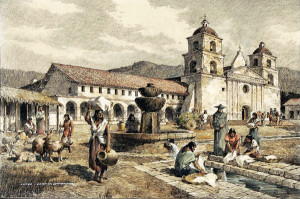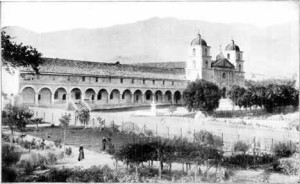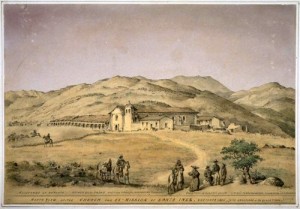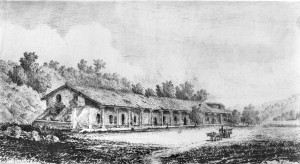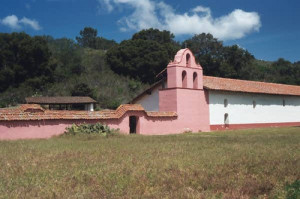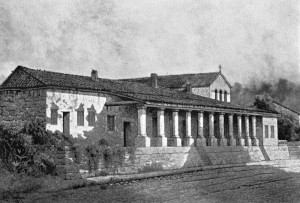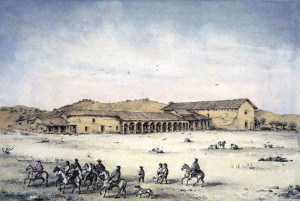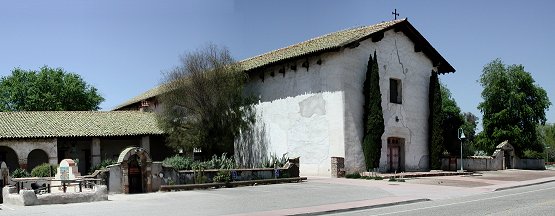In Part Two of the four part series on the California Missions I will discuss five of the twenty-one missions: Mission Santa Barbara, Mission San Ines, Mission La Purisima Concepcion, Mission San Luis Obispo de Tolusa and Mission San Miguel Arcangel that are all located in Central California. But, first a brief history of the California Missions …
In the 17th century Spain sent the Portola expedition led by the Governor of Baja California, a group of military soldiers and several Franciscan Friars. The expedition would establish permanent settlements in Alta California, defended by the soldiers and Father Junipero Serra was put in charge of the padres that would convert the Native American population to Christianity.
Then, in 1833, the Act for the Secularization of the California Missions followed by the Decree of Confiscation in 1834 removed the administration of the Missions from the Catholic Franciscan Padres and given to the Mexican government. Eventually the vast properties of the Missions were divided and land grants were given to prominent Mexicans.
In 1848, after the Mexican-American War and when California became the 31st State in 1850, the United States Army occupied many of the Missions. Some of the Missions were used as garrisons and the soldiers lived in converted barracks. Ultimately, on March 18, 1861, President Abraham Lincoln decreed that the California Missions should be returned to the Catholic Church. Throughout the following years many of the Missions were abandoned or neglected and fell into disrepair while others became local parishes of the Catholic Church that are still in use today.
Now, the five missions of the Central California …
Mission Santa Barbara
Mission Santa Barbara was founded by Father Fermin Lasuen on December 4, 1786; it is the 11th Mission of the California Missions. The Mission is named for Saint Barbara and it is located in Central California in the beautiful resort city of Santa Barbara. Today it remains the only California Mission still under the continuous administration of the Franciscan Order.
Centuries before the Mission Santa Barbara was established, a Spanish explorer Sebastian Vizcaino visited the region. This was almost 60 years before another Spanish explorer named Juan Cabrillo had traveled up the coast of Alta California in 1542. Later, in 1782, the Portola expedition of Spanish military soldiers and Franciscan padres visited the area and the site was noted as a possible location for a future Mission. But it took several more years before the Mission Santa Barbara was established because Governor Felipe de Neve and Father Junipero Serra did not agree as to when the Mission would be built, Governor de Neve felt that the establishment of the Presidio took priority over the building of the Mission. Finally in 1784, Father Serra received confirmation that the funds were available to precede with the construction. Unfortunately Father Serra died shortly afterwards and Father Lasuen took over the administration of the California Missions.
Over the next decade, three different churches were built on the site. The first church was a small building was erected with a thatch roof and dirt floors. Then in 1789, a larger adobe church was built with a clay tile roof. By 1794, an even larger church was built to accommodate the growing Mission population and a large quadrangle was also built to enclose the Mission church, dormitories, kitchen, storage rooms and warehouses. A large Moorish-style fountain was built in 1808 and it was part of a larger water system of the Mission with a dam (still located in the present day Santa Barbara Botanical Garden), two reservoirs, aqueducts and even a stone laundry basin located in front of the Mission.
After the Mission was severely damaged in the 1812 Santa Barbara earthquake the decision was made to rebuilt the church. It has been said that the inspiration came from a book on ancient architecture that the padres had in the Mission library, in particular a Roman temple originally designed by Vitruvio Polion in 27 B.C. Construction began shortly after the earthquake and was completed in 1820; the new church measured 161 feet in length, 27 feet wide and 42 feet high. The Greco-Roman style stone façade features several Doric columns positioned below a triangular pediment with 87 feet high toers on both sides, the first tower was built was completed in 1820 and the second tower was completed in 1833. After another earthquake hit the Santa Barbara area in 1925 and afterwards the stone façade was rebuilt and reinforced with steel and concrete, but the interior of the Mission church has remained unchanged since 1820.
The Mission Santa Barbara is different than the other 20 California Missions in the fact that it has been continuously occupied by the Franciscan Order. After the Mexican government secularized the California Missions in 1833, the new head of the Franciscan Order, Father Narciso Duran, moved the headquarters to the Mission Santa Barbara and later the new Bishop of California also set up his headquarters at the Mission. For these reasons, the Mission Santa Barbara became the oldest library in the State of California which has been continuously administrated by the Franciscan Order. The library and archives hold the original journals and letters of Father Junipero Serra, over 3,000 original California Mission documents that were formerly held at the other various 21 Missions and also a large collection of books, maps and prints pertaining to the early history of California.
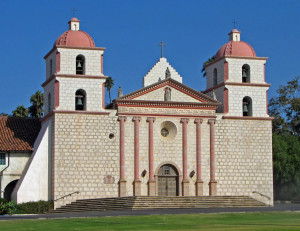
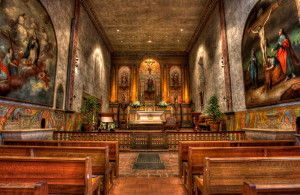
In 1861, when President Lincoln decreed that the California Mission be returned to the Catholic Church, the deed for the Mission Santa Barbara was officially given to the Franciscan Order. The property and buildings directly adjacent to the Mission were used as throughout the following years as a higher learning facility and in 1901 it became the Saint Anthony’s Seminary. Today, the city of Santa Barbara has grown into a resort destination and the area near the Mission has been surrounded by private residences. Mission Santa Barbara, the “Queen of the Missions” remains an active local Catholic parish of the Diocese of Los Angeles.
Mission Santa Ines
Mission Santa Ines (Ynez) was founded on September 17, 1804 by Father Estevan Tapis; it is the 19th California Mission. The Mission is named for St. Agnes of Rome and is located in the San Ynez Valley near the charming city of Solvang. It was established to be halfway between the Mission Santa Barbara and Mission La Purisima Concepcion to serve the large Chumash Native American population that lived on the central coast area of Alta California. By 1812, the Mission church was completed and then disaster struck when a large earthquake centered 45 miles southwest in Santa Barbara and destroyed the building. The new church, completed in 1817, was rebuilt with sturdy 5 foot thick walls and pine beams made from the trees in the local mountains; the appearance of the interior has changed very little since 1820.
After months of Native American unrest against the Spanish military soldiers and the Franciscan padres, the Chumash Revolt of 1824 was started after a soldier at the Mission San Ines attacked a young Native American girl. In retaliation the Chumash attacked the Mission and set fire to the property. When the confrontation was over, the Mission Church was burning but, suddenly feeling concerned about what they had done, the Chumash quickly put out the fire and the building was saved. Afterwards, still unhappy with their controlled treatment by the Spanish soldiers and the Franciscan padres, most of the Chumash left the Mission never to return.
In 1833, the California Missions were secularized and the surrounding property of the Mission Santa Ines was divided and given away as land grants. Then in 1843, the Mexican governor once again took control of the land and gifted 34,499 acres in the Santa Ynez Valley to the Archdiocese of Los Angeles and the College of Our Lady of Refuge was created as the first Catholic seminary in California. Almost forty years later the college was closed and abandoned in 1881, the land was eventually sold to private owners the following year.
The Mission buildings fell into disrepair and Father Alexander Buckler of the Capuchin Franciscan Order slowly began renovations which continued until his death in 1930. Much later in 1949, from funds received by the William Hearst Foundation, the dilapidated bell tower of the Mission was fully restored. The mural on the walls of the interior Mission church which were painted over were also being uncovered and restored, the wooded figurine of Saint Agnes reverently still stands near the center of the altar. Throughout the years, the charming Danish village of Solvang has been built nearby and today the Mission Santa Ines is used by the local parish of the Archdiocese of Los Angeles.
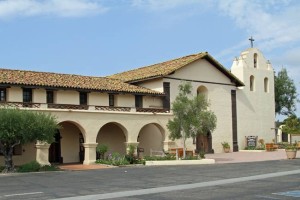
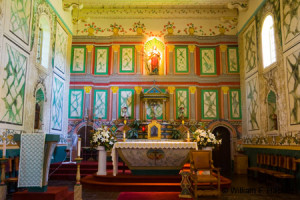
Mission La Purisima Concepcion
Mission La Purisima Concepcion was founded on December 8, 1787 (the Feast of the Immaculate Conception) and is located near the present day city of Lompoc; it is the 12th California Mission to be established. The Mission church construction was started in 1788 and completed in 1791. The Chumash Native Americans in the region were initially receptive to the Mission System and there were several hundred baptisms performed during the first years of the Mission La Purisima. The Mission also prospered by increasing their livestock herds to over three thousand cattle, over five thousand sheep, over three hundred horses and almost 40 mules. Then, in 1812, a devastating earthquake stuck the region followed by a series of aftershocks that severely damaged the Mission La Purisima. The decision was made to move the Mission several miles to the east and a new church was built and completed in 1815, the ruins of the original Mission can still be seen today in Lompoc.
In 1823, Mexico fought and won their independence from Spain and hostilities were developing between the new government and the remaining Spanish soldiers who began to take out their frustrations on the local Native Americans. As previously mention in the section on the Mission Santa Ines, the Chumash Revolt of 1824 was started in retaliation after a Spanish soldier attacked a Native American girl. The Chumash in the region rebelled against the remaining Spanish military and also the Franciscan padres. At the Mission La Purisima several Native Americans took hold of the Mission’s buildings and barricaded themselves inside for over a month until a group of soldiers from the Monterey area arrived to regain control of the Mission, 16 Chumash were killed and many more wounded. Afterwards, the Chumash fled the area for fear of continuing under what they thought of as harsh and unfair conditions. (Mission Trivia: In recent times legends of the haunting of Mission La Purisima have been documented. Park rangers, tour guides and visitors to the Mission have reported hearing flutes playing and ghostly voices, eerie drafts of cold air and ominous shapes seen which are all said to be the restless spirits of the Chumash Native Americans who perished at the Mission)
From 1834 to 1843, the newly independent Mexican administration secularized the California Missions and as a result of this decision the Mission La Purisima was abandoned and the land was given away or sold. Then, in 1934, 500 acres of the Mission property was acquired by the County of Santa Barbara. The Civilian Conservation Corps (CCC) started the restoration process of the remaining nine buildings of the Mission using centuries-old building techniques; such as creating molds for 11,000 adobe bricks, 32,000 terra-cotta roof tiles and 10,000 interior floor tiles. The Mission buildings and original water system were fully restored and completed by 1941. (Historical Note: The Mission La Purisima gardens were also fully restored in the mid to late 20th century. E.D. Rowe, a horticulturist, extensively researched the journals of the padres and other Mission records to find what original plants and trees were used. Today the gardens of Mission La Purisima contain some of the finest examples of early Californian flora. If you are interested, I would highly recommend taking some time to walk in the beautiful gardens, each plant is labeled for easy identification)
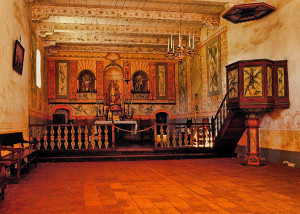
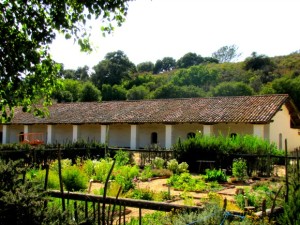
Today, the Mission is no longer used as a Catholic parish but instead it has become part of the La Purisima Mission California State Historic Park that includes 967 acres with a comprehensive visitor center and guided tours which is administrated and maintained by the California Department of Parks and Recreation. The Mission is also noted today as a living history venue which features volunteers dressed in period costumes and demonstrating crafts dating back to the mid to late 18th century.
Mission San Luis Obispo de Tolosa
The Mission San Luis Obispo de Tolosa was founded on September 1, 1772 by Father Junipero Serra near the present day city of San Luis Obispo; it is the 5th California Mission. The Mission was named for Saint Louis of Anjou who was the bishop of Toulouse, France. Several years earlier, in 1769, the Spanish Portola expedition entered the area which they called the “Valley of the Bears” because of the abundance of bears, soldiers of the expedition returned a year later to establish a military settlement and the Mission Carmel a little further north up the coast near Monterey Bay. Several years later, when food sources at the Presidio and Mission Carmel started to decrease, a hunting party was sent south to the Valley of the Bears to secure a fresh supply of bear meat and Father Serra decided that the location would be a good site to establish another Mission, the Mission San Luis Obispo would eventually be built near the San Luis Obispo Creek. Between 1794 and 1809, the Mission San Luis Obispo went through extensive building construction. The Mission church was an unusual L-shaped design, most church were traditionally built in a standard cross shape. Additional buildings were constructed and eventually enclosed within the large quadrangle in 1819. To celebrate the completion of the Mission, two bells made in Lima, Peru where placed in the bell tower.
After the California Missions were secularized, the Mission San Luis Obispo property was divided and sold. Then in 1846, John Fremont and his group of military soldiers, known as the “California Battalion”, used the Mission San Luis Obispo as their headquarters during the “Bear Flag Revolt” and the buildings were converted into barracks. Later, the Mission was abandoned and several years passed before it was used as the San Luis Obispo County’s first courthouse and jail. Then, in 1933, the Mission underwent an extensive restoration project and it is the centerpiece of the Plaza in downtown San Luis Obispo, the Mission is currently used as a Catholic parish church of the Diocese of Monterey.
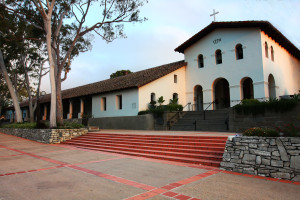
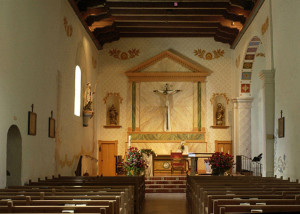
Mission Trivia: Today, the California Missions have become known for their iconic red clay tiled roofs but the roofs of the first Missions were mostly made of dried grass. As the years passed and there were several instances when the thatched roofs caught fire and destroyed the buildings this prompted the need to find a more fire-resistant material. The padres at Mission San Luis Obispo recalled the tiled roofs of their native Spain and soon began making tiles from the local red clay; they supplied the tile for many of the 21 California Missions. Water and clay were mixed together and then flattened to the correct thickness and then placed over curved wooden forms with a layer of sand used between the clay and the form to keep the tiles from sticking, the tiles were approximately 22″ long and tapered 12″ to 20” across. After trimming off the edges excess clay, the tiles were first dried in the sun and then baked in a kiln.
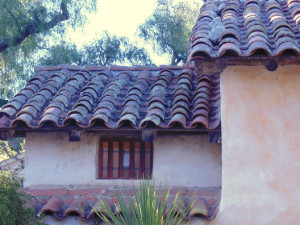
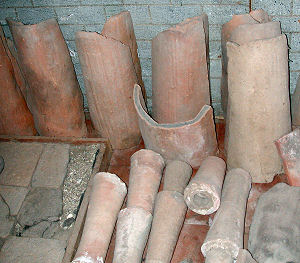
Mission San Miguel Arcangel
Mission San Miguel Arcangel was founded on July 25, 1797 by Father Lausen and it is named for Saint Michael the Archangel; it is the 16th of the California Missions. The location of the Mission was considered ideal since it was situated in a fertile valley and near two rivers, the Nacimiento and the Salinas. The site was also within easy travel distance from the San Joaquin Valley which had a large population of Native Americans which the Franciscan padres hoped to convert to Christianity. A small wooden chapel was originally built but within a year it was replaced by a larger adobe church, unfortunately it destroyed by fire in 1806. The current church was built between 1816 and 1818; it is 144 feet long and 27 feet wide with a 40 feet high ceiling. The interior walls of the church were painted by Estevan Munras, a Spanish artist, in 1818 but the beautiful and vibrant colors of the murals, trompe l’oeils (a painting specifically created to give the illusion of a three-dimensional object) and reredos (a decoration behind the altar of a church usually depicting religious images) can still be seen today.
The history of the Mission San Miguel follows like most of the California Missions through the Act for the Secularization of the California Missions then by the Decree of Confiscation which removed the administration of the Missions from the Catholic Franciscan Padres and given to the Mexican government. Like the other Mission the properties of Mission San Miguel but years later President Abraham Lincoln decreed that the California Missions should be returned to the Catholic Church. Today, the Mission is currently a local Catholic parish church of the Diocese of Monterey. Recently, the Mission suffered damage from the 2003 San Simeon earthquake, restoration work was required and it reopened in September 2009.
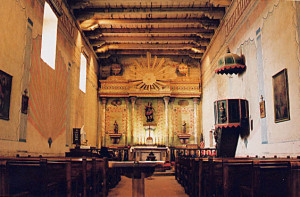
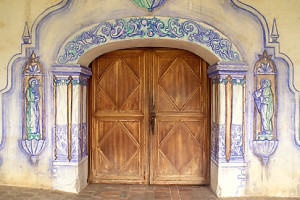
Mission Trivia: Located a short distance from the Mission San Miguel is a campanario (a bell tower or wall which usually stands alone and unattached to a building) which was built during a restoration project in 1939. The campanario holds three bells each weighing 2,000 pounds, the bells were recast in 1888 from the bells taken from the other missions. Originally one of the bells was hung from a large wooden scaffold in front of the Mission San Miguel.
This concludes Part Two of the four part series on the California Missions. In the series, l discuss all of 21 Missions moving from southern to northern California and starting with the first Mission located in San Diego to the San Buenaventura Mission in Part One, then from the Santa Barbara Mission to the San Miguel Arcangel in Part Two and from San Antonio de Padua to the Santa Cruz in Part Three and then from the Santa Clara de Asis Mission to the most northern Mission San Francisco de Solano in Part Four.

